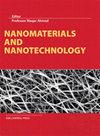Development of graphitic carbon nitride supported novel nanocomposites for green and efficient oxidative desulfurization of fuel oil
IF 3.3
3区 材料科学
Q2 MATERIALS SCIENCE, MULTIDISCIPLINARY
引用次数: 4
Abstract
The catalysts utilized for oxidative desulfurization have acquired significant attention and ability to improve the quality of the fuel oil by removing sulfur. In this work, the catalysts used for oxidative desulfurization include CoWO4 and Bi2WO6 with graphitic carbon nitride (g-C3N4) as support were synthesized by the one-pot hydrothermal method. Graphitic carbon nitride was obtained by thermal polycondensation of melamine at 550°C for 5 h. These catalysts were homogeneously dispersed on the surface of the support and their structure, morphology, and properties were determined by different characterization techniques (Powder X-Ray Diffractometer, Fourier Transform Infrared Spectroscopy, Scanning Electron Microscopy and Energy Dispersive X-Ray Spectroscopy, Specific Surface Area (Brunauer, Emmett and Teller (SBET)). The parameters that affect the efficiency of the desulfurization process such as catalyst amount, amount of oxidizing agent, and reaction temperature have been optimized thoroughly. The oxidative desulfurization reaction was studied in terms of kinetics which shows that reaction is pseudo first order. The thermodynamic studies revealed that the reaction is endothermic and spontaneous in nature. The results determined that the catalytic efficiency for the removal of sulfur (as dibenzothiophene) is more than 90% in the presence of support (g-C3N4) to obtain sulfur free fuel.用于燃料油绿色高效氧化脱硫的石墨氮化碳负载新型纳米复合材料的研制
氧化脱硫催化剂在提高燃料油脱硫质量方面受到了广泛的关注。本文以石墨化氮化碳(g-C3N4)为载体,采用一锅水热法合成了氧化脱硫催化剂CoWO4和Bi2WO6。将三聚氰胺在550℃下热缩聚5 h得到石墨化氮化碳。这些催化剂均匀地分散在载体表面,并通过不同的表征技术(粉末x射线衍射仪,傅里叶变换红外光谱,扫描电子显微镜和能量色散x射线光谱,比表面积(Brunauer, Emmett和Teller (SBET))确定了它们的结构,形态和性能。对催化剂用量、氧化剂用量、反应温度等影响脱硫效率的参数进行了全面优化。对氧化脱硫反应进行了动力学研究,结果表明该反应为准一级反应。热力学研究表明,该反应为吸热自发反应。结果表明,在载体(g-C3N4)存在下,催化脱除硫(如二苯并噻吩)的效率可达90%以上,得到无硫燃料。
本文章由计算机程序翻译,如有差异,请以英文原文为准。
求助全文
约1分钟内获得全文
求助全文
来源期刊

Nanomaterials and Nanotechnology
NANOSCIENCE & NANOTECHNOLOGY-MATERIALS SCIENCE, MULTIDISCIPLINARY
CiteScore
7.20
自引率
21.60%
发文量
13
审稿时长
15 weeks
期刊介绍:
Nanomaterials and Nanotechnology is a JCR ranked, peer-reviewed open access journal addressed to a cross-disciplinary readership including scientists, researchers and professionals in both academia and industry with an interest in nanoscience and nanotechnology. The scope comprises (but is not limited to) the fundamental aspects and applications of nanoscience and nanotechnology
 求助内容:
求助内容: 应助结果提醒方式:
应助结果提醒方式:


